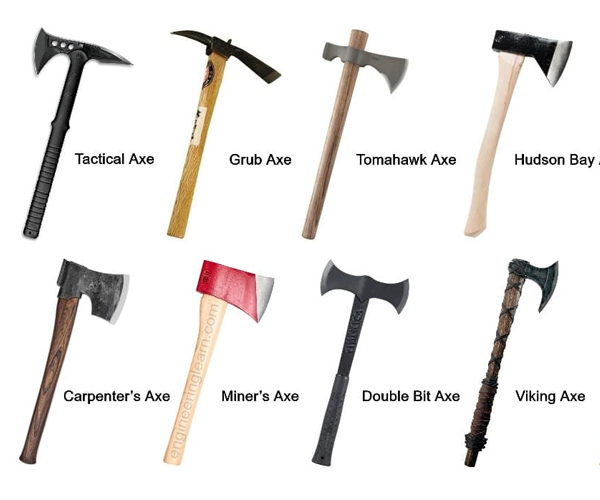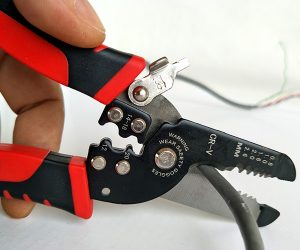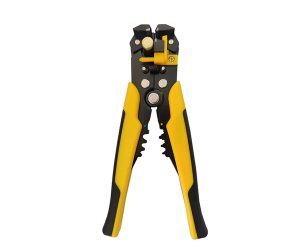When it comes to axes, the variety of types and their specific uses can be overwhelming. From chopping wood for fire to completing intricate woodworking tasks, choosing the right axe for the job is crucial. In this article, we’ll explore 20 different types of axes, their uses, and how to select the best one for each task. Whether you’re a professional or a DIY enthusiast, this guide will help you navigate the world of axes and make an informed decision.
1. What are the different types of axes?
Axes come in many shapes and sizes, each designed for a specific task. Understanding the different types of axes available and their unique features is the first step to selecting the right one for your needs. But here’s the kicker—choosing the right axe isn’t just about picking the sharpest one! The type of wood or material you’re working with, along with the task at hand, will dictate which axe is best for the job.
A common distinction is between axes used for felling, splitting, and chopping. Felling axes, for example, are long and heavy, ideal for cutting down trees. They’re designed to deliver powerful blows with minimal effort. On the other hand, splitting axes are shorter, with a wedge-shaped blade to split logs more efficiently.
Another key factor to consider is the axe handle. Axes come with wooden, fiberglass, or steel handles, each offering a unique balance and durability. Choosing an axe with the right handle material can make all the difference in comfort and control. The length of the handle also affects leverage, allowing you to chop more efficiently with a longer handle.
Let’s take a look at a few examples of popular axes and their uses:
| Axe Type | Use Case | Handle Type | Blade Material |
|---|---|---|---|
| Felling Axe | Cutting down trees | Wooden, Fiberglass | High-carbon Steel |
| Splitting Axe | Splitting logs | Fiberglass, Steel | Hardened Steel |
| Hatchet | Light chopping, camping | Wooden, Fiberglass | Stainless Steel |
| Tomahawk | Hunting, chopping small branches | Wood, Fiberglass | Carbon Steel |
Each axe type is designed to maximize efficiency in specific tasks. Understanding these distinctions will help you choose the right tool for your next project.
2. Why do you need different types of axes?
When you think of axes, you probably imagine one tool that does it all, right? Well, here’s the thing: axes are specialized tools, and using the wrong one can make a huge difference in your results. You might think any axe can do it all, but this is where it gets interesting—the wrong axe could cause unnecessary strain, lead to inaccurate cuts, or even damage the wood.
For example, felling a tree requires a different kind of axe than splitting logs for firewood. Felling axes are designed to make clean cuts deep into the trunk of a tree, while splitting axes focus on the grain of the wood to separate it into smaller pieces. The wrong axe could leave you struggling to get the job done, and no one wants that.
Moreover, using the right axe can enhance your overall experience, whether you’re out camping, working on a DIY project, or taking on a professional task. A lightweight hatchet is perfect for quick jobs, while a sturdy, heavy-duty axe is needed for bigger jobs like clearing land or cutting down trees. Choosing the correct axe helps you work smarter, not harder.
It’s not just about getting the job done—it’s about doing it efficiently and safely. What’s the real story? The right axe makes the job easier, more enjoyable, and much safer.
| Axe Type | Task | Ideal Use | Benefits |
|---|---|---|---|
| Felling Axe | Cutting down trees | Heavy, powerful cuts | Fast, efficient |
| Splitting Axe | Splitting logs | Separate logs quickly | Easier on the body |
| Hatchet | Light chopping, camping | Portable, small tasks | Compact and versatile |
| Axes for Car Repair | Auto maintenance | Precision cuts | Durable, precise |
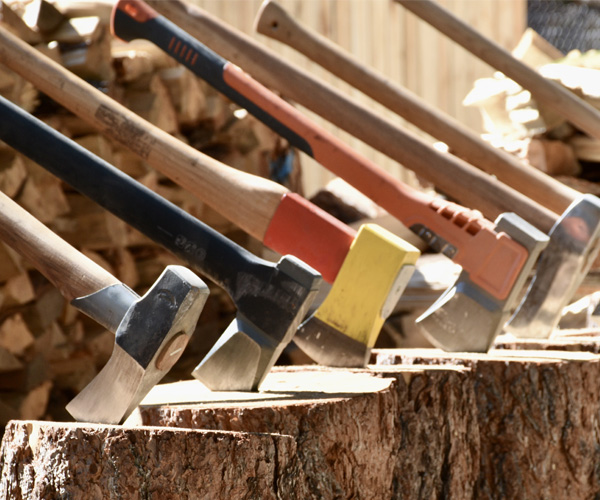
3. What are the key factors to consider when selecting an axe?
Selecting the right axe can be more complicated than simply picking the most attractive one off the shelf. Ready for the good part? The factors that influence your axe choice include the type of job you’re doing, the axe’s design, and even your personal comfort. Here are the key factors to think about:
- Axe Purpose: What do you need the axe for? Is it for chopping down trees, splitting firewood, or light camping work? Each task requires a specific type of axe. For instance, a felling axe is suited for cutting down trees, while a splitting axe is better for splitting logs.
- Handle Material and Length: The material and length of the handle affect the comfort, strength, and balance of the axe. Wooden handles are traditional and offer a classic feel, but fiberglass and steel handles tend to be stronger and lighter.
- Blade Shape and Weight: The blade’s shape is designed for the type of work it is meant to do. A felling axe has a thinner, more tapered blade, while a splitting axe features a wedge-shaped blade. The weight of the blade influences the power of the strike—heavier axes are best for felling, while lighter axes are more versatile.
Let’s take a look at how these factors come into play when choosing an axe:
| Factor | Felling Axe | Splitting Axe | Hatchet |
|---|---|---|---|
| Handle Length | Longer for leverage | Medium for control | Short for portability |
| Handle Material | Wooden or fiberglass | Fiberglass or steel | Wooden or fiberglass |
| Blade Shape | Thin, curved | Wedge-shaped | Thin and flat |
| Weight | Heavy | Moderate to heavy | Light |
Choosing the right combination of these factors will ensure that your axe works best for your particular task, maximizing efficiency and comfort.
4. What are the main types of axes used for woodworking?
Woodworking requires specific types of axes designed to handle the intricacies of shaping and cutting wood. This is where it gets interesting—axes designed for woodworking differ from those used for felling or splitting, offering features that make them ideal for fine, detailed work.
- Felling Axes: Felling axes are long-handled axes with a narrow, sharp blade designed to cut through the grain of the tree. They’re ideal for chopping down trees quickly.
- Hatchets: Smaller than traditional axes, hatchets are designed for light chopping and can be used in confined spaces. They’re perfect for campfire prep or small woodworking tasks.
- Carpenter’s Axes: These axes have a flat side, making them great for carving, chopping, and trimming wood. They’re perfect for detailed woodworking projects.
Woodworking axes often have a longer, more balanced handle for better control during delicate cuts. And, as with all axes, it’s essential to select the right one for the job at hand.
| Axe Type | Best Use | Features | Ideal Task |
|---|---|---|---|
| Felling Axe | Cutting trees | Long handle, sharp blade | Cutting down trees |
| Hatchet | Light chopping, camping | Short handle, compact size | Small jobs, camp prep |
| Carpenter’s Axe | Fine woodworking | Flat side for control | Detailed carving and trimming |
Choosing the right woodworking axe makes all the difference in achieving precision and ease in your projects.
5. How does a felling axe differ from a splitting axe?
While both axes may look similar, they serve very different purposes. But here’s the kicker—using a felling axe to split logs is not only inefficient but can also be dangerous.
- Felling Axe: Felling axes are designed for chopping down trees, and they have a long, thin blade that allows them to slice through wood fibers efficiently. The primary purpose is to cut across the grain of the tree, making deep, controlled cuts to bring the tree down.
- Splitting Axe: In contrast, splitting axes are designed to split wood along its grain. The blade is wider and wedge-shaped, allowing it to force the wood apart with a single strike. The weight of the splitting axe is typically greater, as it needs to generate the force necessary to break through the wood.
The blade of a felling axe is sharp and thin, which makes it ideal for cutting across the grain of the tree, while the wedge-like design of the splitting axe is better suited for working with logs and firewood.
| Axe Type | Purpose | Blade Shape | Use Case |
|---|---|---|---|
| Felling Axe | Cutting down trees | Thin, sharp blade | For felling trees |
| Splitting Axe | Splitting logs | Wedge-shaped, thick blade | For splitting firewood |
So, while both axes have their place in the woodcutting world, it’s essential to know which one is best for each task. Choosing the right tool makes all the difference in getting the job done safely and efficiently.
6. What are hatchet axes and when should you use them?
Hatchet axes are smaller, lighter axes that are perfect for a variety of tasks, especially those that require more precision and control. What’s the real story? Hatchets are incredibly versatile tools that can be used in a wide range of situations, from camping and hiking to light home repairs.
One of the main advantages of a hatchet is its portability. With a short handle and a compact blade, it’s easy to carry around and use for quick tasks. Whether you’re chopping kindling for a fire or trimming branches while hiking, a hatchet can handle it all. It’s an essential tool for anyone who spends time outdoors.
Another important feature of hatchets is their control. The smaller blade allows for greater precision, making them ideal for tasks that require detailed work. Whether you’re carving wood, shaping a small piece of furniture, or making minor repairs around the house, a hatchet gives you the accuracy you need.
But here’s the kicker—while they are lightweight and versatile, hatchets are not designed for heavy-duty tasks. They’re not meant to chop down large trees or split big logs. For those kinds of jobs, you’ll need a heavier, more specialized axe.
| Feature | Hatchet Axe | Felling Axe | Splitting Axe |
|---|---|---|---|
| Weight | Light, compact | Heavy | Moderate to heavy |
| Ideal Use | Light chopping, carving | Tree felling | Splitting logs |
| Precision | High, for detailed work | Moderate, for deep cuts | Low, focused on splitting |
Hatchets are excellent for quick, light work, and when you’re out on the trail or in the yard, you’ll appreciate their balance between portability and function.
7. What are the different axes used for car repair?
Axes are often overlooked in the world of car repair, but certain types of axes can be essential for various mechanical tasks. Ready for the good part? Car repair axes are designed to handle more precise cutting and stripping tasks, often used for cutting through materials like metal or plastic in automotive repair work.
One common use for axes in car repair is removing damaged or unwanted parts, such as cutting through rusted panels or broken components. These specialized axes, often referred to as “utility axes,” feature a thinner blade for more detailed, controlled cutting. They are smaller in size but still powerful enough to handle tough materials. These axes are particularly useful when working on older cars, where removing rust or old parts is essential to restoring functionality.
Another important tool is the “mechanic’s axe,” which is designed for automotive mechanics who need to make quick cuts in tight spaces. The small size and sharp blade make it perfect for maneuvering around engine components and other car parts.
The right axe for car repair depends on the nature of the job, but in general, these axes are compact, strong, and precise, providing you with a tool that can handle tough, intricate tasks.
| Axe Type | Purpose | Features | Best Use |
|---|---|---|---|
| Utility Axe | Cutting through tough materials | Thin blade, compact size | Removing car parts, repairs |
| Mechanic’s Axe | Quick, precise cuts | Sharp blade, small size | Working in tight spaces |
| Hatchet | Light chopping, trimming | Short handle, sharp blade | Cutting small components |
These axes allow mechanics to get into tight spaces and perform detailed repairs that would otherwise be difficult with larger, bulkier tools. It’s all about having the right tool for the job.
8. What is a double-headed axe and how is it used?
A double-headed axe, as the name suggests, features two blades instead of one. This unique design offers a number of advantages, but this is where it gets interesting—it isn’t just about having twice the cutting power!
The double-headed axe is an ancient tool that has been used for thousands of years. It’s commonly associated with battle axes, but its design is also ideal for felling trees or chopping wood in more traditional settings. The main benefit of having two heads is the ability to alternate between cutting and shaping the wood without having to flip the axe over or change sides.
These axes were historically used in combat because of their ability to deliver powerful strikes with both sides. However, for modern applications, they are typically used by professionals or enthusiasts who need a highly efficient tool for heavy-duty tasks. The two blades allow for quicker work and greater versatility, but they can also be heavier and harder to control than a single-blade axe.
While double-headed axes are less common in everyday use, they still serve as an excellent tool for specialized tasks that require precision and power.
| Feature | Double-Headed Axe | Single-Headed Axe |
|---|---|---|
| Cutting Power | Dual blades for increased power | Single blade for focused cuts |
| Weight | Heavier, more challenging to control | Lighter, easier to manage |
| Best Use | Specialized, heavy-duty tasks | General-purpose cutting and felling |
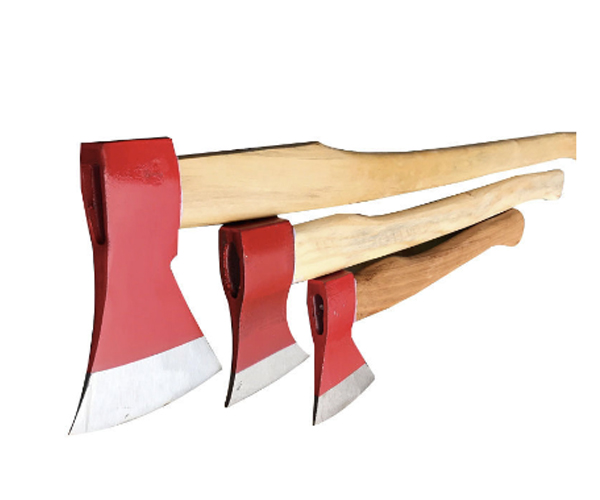
Double-headed axes are often a favorite among collectors and professionals who value their historical significance and practical design for specific tasks.
9. What is the purpose of an axe for camping and survival?
An axe is one of the most versatile tools you can carry while camping or in a survival situation. But here’s the kicker—an axe is not just for chopping wood. It can also be used for cutting, building shelters, preparing food, and much more. In survival situations, having the right axe is critical to your ability to stay safe and thrive in the wilderness.
For camping, axes are essential for chopping firewood, clearing brush, or building a shelter. A survival axe is typically smaller and more portable, making it easier to carry around, while still being large enough to perform important tasks. Many survival axes also feature a blade on one side and a flat or hammer-like surface on the other side, allowing them to double as a tool for driving tent stakes or splitting small logs.
When selecting a camping or survival axe, it’s important to choose one that balances size, weight, and functionality. A small hatchet is a good choice for lightweight tasks, while a larger axe may be needed for chopping larger pieces of wood or building more complex shelters.
| Axe Type | Ideal Use | Features | Best For |
|---|---|---|---|
| Survival Axe | Emergency situations | Compact, multi-use | Firewood, shelter building |
| Camping Axe | Light outdoor tasks | Lightweight, portable | Chopping small wood, camping |
| Hatchet | Small, light tasks | Short handle, easy to carry | Cutting branches, chopping kindling |
Having a reliable axe for camping and survival is a game-changer, offering you the ability to perform multiple essential tasks with ease.
10. What is the difference between an axe and a machete?
While both tools are used for cutting and clearing, axes and machetes have different shapes and designs, making them suited for different tasks. What’s the real story? While an axe is built for chopping, a machete is designed for slicing through brush or smaller branches. Both tools are incredibly useful, but knowing which one to choose depends on your specific needs.
A machete has a long, thin blade that is perfect for cutting through dense underbrush or clearing vegetation. The design is optimized for slicing, making it effective for cutting smaller branches and clearing trails. Machetes are lighter than axes, which makes them easier to carry over long distances.
On the other hand, an axe is heavier and has a larger blade, designed to chop through thicker wood or trees. Axes are better for tasks that require more force, like felling trees or splitting logs. The added weight allows you to generate more power with each strike.
| Tool | Best For | Design | Ideal Use |
|---|---|---|---|
| Axe | Heavy cutting, felling trees | Wide blade, heavy handle | Tree felling, wood splitting |
| Machete | Clearing vegetation, light cutting | Thin, long blade | Clearing trails, cutting brush |
In conclusion, while both tools serve vital purposes, understanding the task at hand will help you choose the best one for the job.
11. How do you care for and maintain your axes?
Taking proper care of your axes is essential to ensuring they last for years and continue to perform at their best. Ready for the good part? Proper maintenance not only keeps your axe sharp but also improves safety, efficiency, and overall performance. Here’s what you need to do to keep your axe in top shape.
1. Sharpening
The key to maintaining an axe’s effectiveness is ensuring it stays sharp. A dull axe requires more effort to cut through wood, which can lead to fatigue and a higher chance of injury. To sharpen your axe, use a sharpening stone or file. Make sure to keep the angle of the blade consistent while sharpening. A sharpening guide can help maintain the correct angle.
2. Cleaning
After each use, clean your axe to remove dirt, sap, or debris. Use a soft cloth or brush to wipe down the blade. For tougher residue, you can use a mild detergent and water. Be sure to dry the axe thoroughly after cleaning to prevent rust.
3. Lubricating the Handle
Wooden handles can dry out and crack if they’re not properly maintained. Apply a light coat of linseed oil or specialized wood oil to the handle. This will help protect it from moisture, prevent splinters, and extend the handle’s life.
4. Storing the Axe
Proper storage is just as important as maintenance. Always store your axe in a dry, cool place. Avoid leaving it outside or in damp areas, as this can lead to rust and deterioration of the handle. If possible, hang the axe by its handle to prevent any pressure from being applied to the blade.
| Maintenance Task | What to Do | Why It’s Important |
|---|---|---|
| Sharpening | Use a sharpening stone or file | Keeps the blade effective |
| Cleaning | Wipe down with a cloth, wash with detergent | Prevents build-up of dirt or rust |
| Lubricating Handle | Apply linseed oil or wood oil | Protects wood, prevents cracks |
| Storing | Store in a dry, cool place | Prevents rust, extends life |
By maintaining your axe properly, you ensure that it stays in excellent working condition and ready for use at any time.
12. What safety precautions should be taken when using an axe?
Using an axe may seem straightforward, but there are a number of safety precautions to keep in mind to avoid accidents and injuries. This is where it gets interesting—a tool like an axe, when used improperly, can be dangerous, but with the right precautions, it can be a safe and effective tool for any job.
1. Protective Gear
Always wear the appropriate protective gear. Safety glasses or goggles will protect your eyes from flying debris. A hard hat or helmet is crucial for protecting your head, especially when working with large logs or trees. Additionally, gloves that offer a firm grip are recommended to reduce the risk of blisters and provide better control over the axe.
2. Axe Handling
Grip the axe firmly but not too tightly. A tight grip can cause your hands to slip, leading to an accident. Hold the axe with both hands, one on the top of the handle and one at the bottom. Keep your hands dry and clean to prevent the axe from slipping during use.
3. Stance
Stand firmly with your feet shoulder-width apart. Keep a balanced stance to maintain control over the axe while striking. When chopping or felling, make sure your target area is clear of obstacles and people. Never swing an axe when someone is in your line of sight.
4. Swinging the Axe
When swinging the axe, do not overextend your arms. Instead, use your entire body to generate force. Keep the axe blade aligned with your target and avoid swinging it in an arc that could cause the blade to deflect.
| Safety Precaution | What to Do | Why It’s Important |
|---|---|---|
| Protective Gear | Wear goggles, gloves, and a helmet | Protects from flying debris and impacts |
| Axe Handling | Grip the axe firmly with both hands | Prevents accidents and improves control |
| Stance | Stand firmly with feet shoulder-width apart | Increases balance and control |
| Swinging the Axe | Swing with controlled force and proper alignment | Prevents accidents, improves precision |
By following these safety guidelines, you can ensure a safer, more efficient experience with your axe.
13. How do you choose the best axe for your specific task?
Choosing the best axe for your specific task might seem like a daunting decision, but here’s the kicker—the right axe can make a world of difference in both your results and the effort required. The key is understanding your needs and selecting an axe that matches them.
1. Know Your Task
Before you choose an axe, you need to understand exactly what you’ll be using it for. Are you felling trees, splitting logs, or doing detailed woodworking? Each task requires a different type of axe. For instance, a felling axe is ideal for cutting trees, while a splitting axe is designed to break logs along their grain. If you’re looking for something versatile, a hatchet might be your best choice.
2. Handle and Blade Considerations
The material and length of the handle, along with the shape of the blade, can greatly affect your axe’s performance. For heavy-duty tasks, a long, strong handle made of wood or fiberglass is ideal. A sharp, sturdy blade will make the work much easier, while a lightweight axe will be more comfortable for smaller jobs.
3. Balance and Comfort
An axe that’s too heavy can cause fatigue, while one that’s too light might not generate enough force for tough jobs. Look for an axe that offers a good balance between weight and handle length. A comfortable grip and ergonomic design are also important to prevent strain during extended use.
| Task | Axe Type | Handle Type | Blade Design |
|---|---|---|---|
| Felling Trees | Felling Axe | Long, wooden or fiberglass | Thin, sharp, curved blade |
| Splitting Logs | Splitting Axe | Medium, fiberglass or steel | Wedge-shaped, heavy blade |
| Carving Wood | Carpenter’s Axe | Shorter, wooden or fiberglass | Flat, thin blade |
Choosing the right axe for the job not only makes your work easier but ensures it’s done safely and efficiently.
14. What are some popular axe brands and models?
There are numerous axe brands and models available, each offering different types and features for various tasks. What’s the real story? Popular brands have established a reputation for quality, durability, and design. Choosing a well-known brand ensures that you’re getting a reliable tool that will perform when needed.
1. Fiskars
Fiskars is a top choice for many professionals and enthusiasts due to its reliable design and quality construction. The Fiskars X27 Super Splitting Axe is perfect for splitting logs, thanks to its long handle and sharp, wedge-shaped blade.
2. Gränsfors Bruk
Known for its hand-forged axes, Gränsfors Bruk is a Swedish company that offers high-quality tools for serious woodworkers and outdoor enthusiasts. Their axes, such as the Gränsfors Small Forest Axe, are designed for precision and are ideal for chopping, carving, and more.
3. Council Tool
Council Tool is another trusted brand that offers a wide range of axes. Their American-made axes, like the Council Tool Wood-Craft Pack Axe, are built to last and perform well in various conditions. These axes are designed for professionals and outdoor enthusiasts alike.
| Brand | Popular Model | Best Use | Features |
|---|---|---|---|
| Fiskars | X27 Super Splitting Axe | Splitting large logs | Long handle, wedge-shaped blade |
| Gränsfors Bruk | Small Forest Axe | Precision carving and chopping | Hand-forged, balanced design |
| Council Tool | Wood-Craft Pack Axe | Outdoor use, camping, light woodwork | Lightweight, durable, versatile |
These brands offer reliable, high-quality axes that cater to a variety of tasks, ensuring that you have the right tool for every job.
15. Where can you buy the best axes for your needs?
Finding the right axe is only half the battle—here’s the kicker—you also need to know where to buy it. Whether you’re shopping online or in-person, it’s important to know where to find quality axes that meet your specific needs.
1. Online Retailers
Online platforms like Amazon, Home Depot, and specialized stores like REI and Cabela’s offer a wide selection of axes. The benefit of shopping online is that you can compare different brands, read customer reviews, and often find better prices. Plus, the convenience of having the axe delivered directly to your door is hard to beat.
2. Local Hardware Stores
For those who prefer to handle tools in person, local hardware stores often have a variety of axes to choose from. These stores can also provide expert advice and recommendations based on your needs.
3. Specialty Stores
For high-end or specialized axes, you might want to check out specialty outdoor retailers or dedicated tool shops. Brands like Gränsfors Bruk and Council Tool often sell directly through their own websites or partner retailers, ensuring that you get authentic, high-quality tools.
| Retailer | Type of Axes Available | Advantages | Where to Find It |
|---|---|---|---|
| Amazon | Wide selection | Convenient, competitive pricing | Online |
| Home Depot | General and professional axes | In-person shopping, expert advice | Local stores, online |
| REI, Cabela’s | High-quality outdoor axes | Great for camping and survival | Online, in-store |
By shopping from trusted retailers, you can ensure that you’re getting the best axe for your needs, backed by customer support and product guarantees.
FAQ
Q1: What is an axe?
An axe is a tool with a heavy, sharp blade attached to a handle, used for chopping, splitting, and shaping wood, or for other tasks requiring a heavy strike.
Q2: How does a splitting axe work?
A splitting axe works by using a sharp, wedge-like blade to force apart logs along their grain. The design is meant to split rather than chop, making it more effective for splitting wood.
Q3: How do I maintain my axe?
To maintain your axe, regularly sharpen the blade, clean it after each use, and store it properly to prevent rust and damage. You should also ensure the handle is securely attached.
Q4: Can I use a hatchet for felling trees?
While a hatchet is suitable for small cutting tasks and chopping branches, it is not ideal for felling large trees. A felling axe, with its longer handle and sharper blade, is better for this job.
Q5: What type of axe is best for survival?
A versatile camping or survival axe with a compact design and sturdy build is ideal for outdoor survival. It should be lightweight, sharp, and capable of handling various tasks like chopping wood or building shelter.

